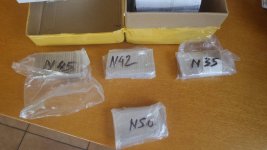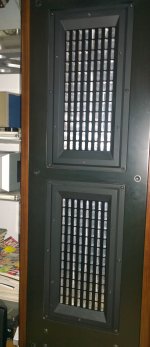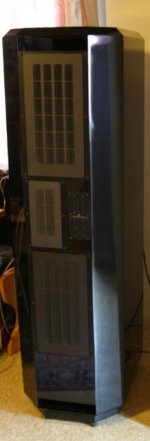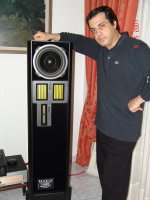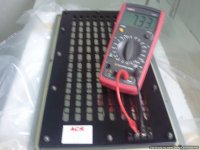Hi to all the newcomers!
George my friend!
Hope you're doing well!
As for the "how low can you go" question all i can say is that i aim at a system that will have significantly larger vibrating area than say Neo 10...Laws of physics predict a better low down responce just by this spec only.
Not that i am relying on this only solely!
I will not cut corners in this!
Also remember that i am not a big fan of dipole operation as it places heavy requirements on room and speaker spacing plus lowers the available SPL and the ability of the driver to reach lower Hz. That imho would make sense in a completely dipole system (even in the woofers). If one wants the dipole sound he can use rear facing drivers (the VMPS 50 is a nice example)...
George my friend!
Hope you're doing well!
As for the "how low can you go" question all i can say is that i aim at a system that will have significantly larger vibrating area than say Neo 10...Laws of physics predict a better low down responce just by this spec only.
Not that i am relying on this only solely!
I will not cut corners in this!
Also remember that i am not a big fan of dipole operation as it places heavy requirements on room and speaker spacing plus lowers the available SPL and the ability of the driver to reach lower Hz. That imho would make sense in a completely dipole system (even in the woofers). If one wants the dipole sound he can use rear facing drivers (the VMPS 50 is a nice example)...
Soundofvoid/Ioannis have you ever read the review I did a few years ago of the JansZen electrostatic speaker (which is NOT a dipole)?Also remember that i am not a big fan of dipole operation as it places heavy requirements on room and speaker spacing plus lowers the available SPL and the ability of the driver to reach lower Hz..............
JansZen electrostatic
I said in my full review which I took down (because I was asked by someone associated with the speaker to do so) that; it was the bridge between box speakers and flat panels speakers (like electrostatics and Magnepans).
I meant that in a very flattering way.
The sound had more body and drive than the sometimes thin and ghostly panel speakers, but it was never flat, fat, slow and opaque like many box speakers can be.
The review sample had a problem with the soundstage because one of them had a minor wiring flaw (out of polarity) which was easily fixed/repaired by the manufacturer. And that was my only real criticism of the speaker's presentation/soundstage (sketches in link).
In other words, I think you are on the right track.
Over the years I have had the opportunity to hear several speakers with ribbons or some kind of panel tweeter/midrange (in non-dipole operation) and have always enjoyed them tremendously.
Perhaps you are reinventing the wheel, but if you get a better wheel out of it, then it will be worth it. Even if it's just an okay wheel, it's your wheel and the process of making it appears to be a delightful learning experience and journey so far.
EDIT:
Looks like David has been developing some new technology himself.
http://www.janszenloudspeaker.com/index.htm
Click on PANELS
An externally hosted image should be here but it was not working when we last tested it.
Each is split electrically down the middle. In the standard configuration, the entire area gets the midrange signal, and only half gets treble. In this way, dispersion is increased and there is no need for a rolloff network to reduce the naturally rising high frequency response.
Last edited:
George i am sorry that i have not read your review.
I am not very active in whatsbestforum lately because i saw a shift to a kind of products (and a similar in mentality) that are (...ahem) beyond my wallet and comprehension...
That is an interesting speaker...and it's a pity it's not very well known.
Let me share some light into why i am doing this:
In the course of many years in the this hobby i have acquired a particular interest in planar speakers.
To my ears their ability to portray speed, attack, resolution, and nuances/harmonics is beyond reproach.
You can't escape mass and inertia...unless you can make a midrange cone that weighs 1 gram...?
I have witnessed this over and over and to these ears it's a fact of life.
I have heard big Infinities, Apogees, Martin Logans, Audiostatics and Magnepans.
Soon i started to realize there are sectors within this group: magnetostatics vs electrostatics, closed back vs dipoles, fullrange vs hybrids...
I've listened to all of them but one has to make up his mind in the end.
I chose hybrid-closed back-magnetostatics because of practicality and potentially excellent sound.
I am not saying in any way that the other types can't play excellent...just that this is the compromise i can live with as:
1)It gives me speed nuance harmonics and detail that is MUSICAL.
2)It gives me bass (i LIKE bass) in a practical shape as it employs woofers that are KINGS low down (unless you can afford the cash and room for MG20's or Analysis Orion)!
3)They can be used as an ordinary speaker with no need for AC power and step up transformers that make things complicated and expensive...
There is a fly in the ointment though and it has a name:integration!
The integration of something having ultra low mass and doing it's job by making minute movements of a large foil area with something that has a heavy cone that moves back and forth several cm IS a problem.
We can't completely solve it but we can ameliorate it and make inaudible.
Three things that (IMHO) can help within the parameters of a certain design:
a)A low crossover point.
b)a boost in bass response of the lower mid region that gives oomph/presence that planars genetically lack.
c)Gently Xover slopes.
As for a) it would be good to be able to cross at around 200 Hz keeping the most of the human voice in one piece.
As for b) you need bigger (or more) panels that can produce creditable low mid frequencies...AND you can put them in a closed back configuration that will boost the critical area.
As for c)the 24db/oct Xovers are the rage because they assign each to their own making life easier on the drivers (and designers).
But they make the speaker a sum of parts instead of a musical instrument...thus musicality suffers!
And they certainly won't help in masking the transition from woofer to panel!
And that brings us to this driver:
I want something that can cross at eg 250hz but will not disintegrate at 100 Hz!
And my woofer will still play a fair bit at 500Hz...
Woofer loading is another topic.
Let's just say i love TL bass...
I am not very active in whatsbestforum lately because i saw a shift to a kind of products (and a similar in mentality) that are (...ahem) beyond my wallet and comprehension...
That is an interesting speaker...and it's a pity it's not very well known.
Let me share some light into why i am doing this:
In the course of many years in the this hobby i have acquired a particular interest in planar speakers.
To my ears their ability to portray speed, attack, resolution, and nuances/harmonics is beyond reproach.
You can't escape mass and inertia...unless you can make a midrange cone that weighs 1 gram...?
I have witnessed this over and over and to these ears it's a fact of life.
I have heard big Infinities, Apogees, Martin Logans, Audiostatics and Magnepans.
Soon i started to realize there are sectors within this group: magnetostatics vs electrostatics, closed back vs dipoles, fullrange vs hybrids...
I've listened to all of them but one has to make up his mind in the end.
I chose hybrid-closed back-magnetostatics because of practicality and potentially excellent sound.
I am not saying in any way that the other types can't play excellent...just that this is the compromise i can live with as:
1)It gives me speed nuance harmonics and detail that is MUSICAL.
2)It gives me bass (i LIKE bass) in a practical shape as it employs woofers that are KINGS low down (unless you can afford the cash and room for MG20's or Analysis Orion)!
3)They can be used as an ordinary speaker with no need for AC power and step up transformers that make things complicated and expensive...
There is a fly in the ointment though and it has a name:integration!
The integration of something having ultra low mass and doing it's job by making minute movements of a large foil area with something that has a heavy cone that moves back and forth several cm IS a problem.
We can't completely solve it but we can ameliorate it and make inaudible.
Three things that (IMHO) can help within the parameters of a certain design:
a)A low crossover point.
b)a boost in bass response of the lower mid region that gives oomph/presence that planars genetically lack.
c)Gently Xover slopes.
As for a) it would be good to be able to cross at around 200 Hz keeping the most of the human voice in one piece.
As for b) you need bigger (or more) panels that can produce creditable low mid frequencies...AND you can put them in a closed back configuration that will boost the critical area.
As for c)the 24db/oct Xovers are the rage because they assign each to their own making life easier on the drivers (and designers).
But they make the speaker a sum of parts instead of a musical instrument...thus musicality suffers!
And they certainly won't help in masking the transition from woofer to panel!
And that brings us to this driver:
I want something that can cross at eg 250hz but will not disintegrate at 100 Hz!
And my woofer will still play a fair bit at 500Hz...
Woofer loading is another topic.
Let's just say i love TL bass...
RE: first item, yea the level of discussion gets too circular for my short attention span, and expensive equipment being discussed so costly that I cannot even dream about owning on the used market one day.whatsbestforum ........ beyond my wallet and comprehension..................
There is a fly in the ointment though and it has a name:integration!
The integration of something having ultra low mass and doing it's job by making minute movements of a large foil area with something that has a heavy cone that moves back and forth several cm IS a problems...
I did a search there on CD players, nothing pops up...........everything is separates and outboard, even at entry level.
RE: integration..............Magenpan has a panel type base system on their desktop satellites. Perhaps an open baffle bass panel would............oops, you are not dipole...............you just dodged so many bullets with your approach - smart man.
I'll try to keep an eye on this thread, lately my interests have been in exercise and cigars, each keeps me out of my house and away from my stereo system.
Must be good for me, I've lost seven inches off my waste in two years................audiophiles are too often afflicted with a thick midsection.😀
Lol...happy for you George!
Just measure your cigar intake!
Audiophiles with remotes = couch potatoes...unless they listen to 45's...
Just measure your cigar intake!
Audiophiles with remotes = couch potatoes...unless they listen to 45's...
I will when i receive the parts from the CNC shop...we had to wait to receive the bakelite sheet for the spacers...
In the mean time i am pouring my brains out trying to master the FEMM...
Interesting findings!
I will post soon...
BUT i have to test mine to see the limits of the specific design...
In the mean time i am pouring my brains out trying to master the FEMM...
Interesting findings!
I will post soon...
BUT i have to test mine to see the limits of the specific design...
I had a pair...and sold them.
Opened them up by drilling out the rivets...replacing them with bolts afterwards.
I mean...who uses rivets on a driver?
I was not very happy with it.
It does not go as low as advertized.
Usable to 500 Hz (single driver).
Of course can benefit from a monopole configuration...again to 250 Hz if you want some gentle Xover space around it.
To my eyes it looks cheap and cheerfull made to a price point and feels like so...
Opened them up by drilling out the rivets...replacing them with bolts afterwards.
I mean...who uses rivets on a driver?
I was not very happy with it.
It does not go as low as advertized.
Usable to 500 Hz (single driver).
Of course can benefit from a monopole configuration...again to 250 Hz if you want some gentle Xover space around it.
To my eyes it looks cheap and cheerfull made to a price point and feels like so...
In the mean time i read somewhere that there is a problem with B&G...maybe it is sold or went under...the main suppliers look that they are out of stock and don't know if they will have them again...So if you really want them you have to be quick!
I have just done a very quick view on this thread.
Are you still going for that 0.25 mm Kapton? That is way too thick! Apogee used 0.025 mm for their bass drivers operating below 500 Hz.
I see that you calculate excursions of +- several mm. That is really not true for such a small diaphragm. The foil cannot tension that much and it will also make a bend with an even force applied - reducing the effective movement to about half. There is no movement around the edges.
If we look at drivers as Fostex FS-21/41, Infinty EMIM/L-EMIM (L-EMIM=Fostex FS-41!) etc. They cannot move very much air and that is also a limiting factor in some designs like the Infinity RS 2.5. You will need a large number of driver for that.
Graz in Australia have some replacement diaphragms for the EMIM, corrugated ones that are not attached on all sides, the are more like ribbons. Sure they will hit the magnets, you need to increase the distance between the them - lowering the efficiency.
If your goal is the use your drivers the all the way down to 200-250 Hz, you will need to move some air... That is difficult for many small planars. The midrange driver of my Magnepan Tympani IVa is 8x140 cm, good to about 400 Hz.
Are you still going for that 0.25 mm Kapton? That is way too thick! Apogee used 0.025 mm for their bass drivers operating below 500 Hz.
I see that you calculate excursions of +- several mm. That is really not true for such a small diaphragm. The foil cannot tension that much and it will also make a bend with an even force applied - reducing the effective movement to about half. There is no movement around the edges.
If we look at drivers as Fostex FS-21/41, Infinty EMIM/L-EMIM (L-EMIM=Fostex FS-41!) etc. They cannot move very much air and that is also a limiting factor in some designs like the Infinity RS 2.5. You will need a large number of driver for that.
Graz in Australia have some replacement diaphragms for the EMIM, corrugated ones that are not attached on all sides, the are more like ribbons. Sure they will hit the magnets, you need to increase the distance between the them - lowering the efficiency.
If your goal is the use your drivers the all the way down to 200-250 Hz, you will need to move some air... That is difficult for many small planars. The midrange driver of my Magnepan Tympani IVa is 8x140 cm, good to about 400 Hz.
Welcome Roger!
The Kapton foil that is readily available is 20 micron (i missed a zero!).
I can find even thinner with glue backing or not if for making a sandwich foil.
The maximum allowance will be either 2.5 or 2mm (that is before hitting the magnets).
Big low mid panels (FS41/LEMIM) have a 5mm between magnets.
Of course i don't know if they reach that limit but that's the design - i have measured it.
If i want it modified i can always cut thinner spacers!
I have talked to Graz many times...clever guy and willing to discuss. We were talking once about the viability of a true bass panel...
About the suspension of the foil:when it is glued on all four sides that limits the displacement - mainly because of the tension applied to the sides and not on top and bottom. That is because all drivers are taller than wider (Piega excepted).
The H.E. LEMIM is made like this: on the sides the very thick foil -0.120mm in total- is just suspended between two foam strips and glued on top and bottom.
It will not go very high with this thickness though...limited to 100-500Hz only.
However all true midrange drivers are glued all way around...even the FS41RP bass panel is like that - i don't know about the old LEMIM.
I am in the dark as to how much bass my design will produce.
I just have to make it and measure.
All i can do is to make it a bit larger than the usual mid... and hope for the best.
Remember that i don't want it for a dipole application, i will be using much stronger magnets and that yes, i am willing to use multiple drivers (pairs/quads).
The Kapton foil that is readily available is 20 micron (i missed a zero!).
I can find even thinner with glue backing or not if for making a sandwich foil.
The maximum allowance will be either 2.5 or 2mm (that is before hitting the magnets).
Big low mid panels (FS41/LEMIM) have a 5mm between magnets.
Of course i don't know if they reach that limit but that's the design - i have measured it.
If i want it modified i can always cut thinner spacers!
I have talked to Graz many times...clever guy and willing to discuss. We were talking once about the viability of a true bass panel...
About the suspension of the foil:when it is glued on all four sides that limits the displacement - mainly because of the tension applied to the sides and not on top and bottom. That is because all drivers are taller than wider (Piega excepted).
The H.E. LEMIM is made like this: on the sides the very thick foil -0.120mm in total- is just suspended between two foam strips and glued on top and bottom.
It will not go very high with this thickness though...limited to 100-500Hz only.
However all true midrange drivers are glued all way around...even the FS41RP bass panel is like that - i don't know about the old LEMIM.
I am in the dark as to how much bass my design will produce.
I just have to make it and measure.
All i can do is to make it a bit larger than the usual mid... and hope for the best.
Remember that i don't want it for a dipole application, i will be using much stronger magnets and that yes, i am willing to use multiple drivers (pairs/quads).
Last edited:
The Infinity L-EMIM are identical to the Fostex FS-41. Someone ordered replacement for L-EMIM and got Fostex FS-41 fram Harman.
I have experience from three different Magnepan speakers. Their diaphragms cannot move very much, 1.6 to 2 mm depending of modell, one way for the wide bass drivers. In pratice that is about +-1 mm for the largest drivers when they hit their slap their diaphragm against the magnets.
The dedicated Tympani IVa midrange drivers have thin Mylar (6µm) and I have modified them with foil conductors (0.0127x2.54 mm). The diaphragm is 80x1445 mm (from memory) and it is divided into four sections of various sizes. Stroke is limited by the tension of the Mylar, it will never hit the magnets - that much of power will melt the Mylar. In order to give a more linear movement, the back plate holding the magnets is slightly curved.
I find it impossible to have a large stroke from a small/narrow diaphragm, there must by a very compliant edge around it and still enough tension to hold the plastic film even. Maybe it need to be under tension by springs? If the film is 7-10 cm wide, I would not expect it to reach +-2 mm under any conditions, the film is not that elastic. Just tension the film and load it with some weights and you will see that there will be a non-linear movement.
In order to get 110 dB at 200 Hz you will need to move about 60 cm3 of air.
I have experience from three different Magnepan speakers. Their diaphragms cannot move very much, 1.6 to 2 mm depending of modell, one way for the wide bass drivers. In pratice that is about +-1 mm for the largest drivers when they hit their slap their diaphragm against the magnets.
The dedicated Tympani IVa midrange drivers have thin Mylar (6µm) and I have modified them with foil conductors (0.0127x2.54 mm). The diaphragm is 80x1445 mm (from memory) and it is divided into four sections of various sizes. Stroke is limited by the tension of the Mylar, it will never hit the magnets - that much of power will melt the Mylar. In order to give a more linear movement, the back plate holding the magnets is slightly curved.
I find it impossible to have a large stroke from a small/narrow diaphragm, there must by a very compliant edge around it and still enough tension to hold the plastic film even. Maybe it need to be under tension by springs? If the film is 7-10 cm wide, I would not expect it to reach +-2 mm under any conditions, the film is not that elastic. Just tension the film and load it with some weights and you will see that there will be a non-linear movement.
In order to get 110 dB at 200 Hz you will need to move about 60 cm3 of air.
The rumor is that Infinity made it's planars outside USA(?) whereas Fostex was Japan only.
I am not so sure they used the same foils...I have in my own possession 3 pcs of FS41 and a friend has a great speaker named SAC Anthaeus that has 4 of them.
The foils in all of them are as tight as day one when in the BETAs of another friend and everywhere i look the foils in old LEMIM are all wrinkled...
The magnets in LEMIM are ceramic when in FS41 are samarium cobalt.
The whole thing looks better made and lasts the test of time much better than LEMIM.
So...perhaps the foils were all made by Fostex but the rest has a different execution.
My XX-500s (16X13 cm) are made of Kapton.Have a +/- 1.5mm displacement. Play down to 400 Hz (back loaded of course).
When it's not tight as a drum and i play certain piano pieces (Blind mice etc) you can hear the kapton slapping on the magnets...meaning it easily reaches that limit.
Lets say that when it's tight, it backs of to +/-1mm.
How much more displacement will i get from a 17X24cm driver?
I'd say easily +/-1.5mm?
So i spread my magnets to 4mm to have some leeway...
We'll just have to wait and see...that's why prototypes are made!
If i remember correctly Magnepans are driven from one side only and use much weaker magnets, so you can't expect them to behave the same.
They rely on big moving surface...much like a normally aspirated engine with a lot of displacement.
I'd like to think (dream) of mine as a smaller engine with a turbo...
By the way that 60 cm3 is from 0 to + whatever or from peak to peak?
I am not so sure they used the same foils...I have in my own possession 3 pcs of FS41 and a friend has a great speaker named SAC Anthaeus that has 4 of them.
The foils in all of them are as tight as day one when in the BETAs of another friend and everywhere i look the foils in old LEMIM are all wrinkled...
The magnets in LEMIM are ceramic when in FS41 are samarium cobalt.
The whole thing looks better made and lasts the test of time much better than LEMIM.
So...perhaps the foils were all made by Fostex but the rest has a different execution.
My XX-500s (16X13 cm) are made of Kapton.Have a +/- 1.5mm displacement. Play down to 400 Hz (back loaded of course).
When it's not tight as a drum and i play certain piano pieces (Blind mice etc) you can hear the kapton slapping on the magnets...meaning it easily reaches that limit.
Lets say that when it's tight, it backs of to +/-1mm.
How much more displacement will i get from a 17X24cm driver?
I'd say easily +/-1.5mm?
So i spread my magnets to 4mm to have some leeway...
We'll just have to wait and see...that's why prototypes are made!
If i remember correctly Magnepans are driven from one side only and use much weaker magnets, so you can't expect them to behave the same.
They rely on big moving surface...much like a normally aspirated engine with a lot of displacement.
I'd like to think (dream) of mine as a smaller engine with a turbo...
By the way that 60 cm3 is from 0 to + whatever or from peak to peak?
Attachments
A membrane suspended on 2 sides with an xmax (0-p) of 1,5mm and the size of 17x24cm would be equal to 50% of a traditional cone speaker cause 2 sides are still.
Where all side supported = 25% ekvivalent "cone" area?!
xmax = 1,5mm:
17x24 100% monopole at 200 Hz 110 dB
17x24 50% monopole at 200 Hz: 104 dB
17x24 25% monopole at 200 Hz 98 dB (2mm: 101 dB)
17x24 25% dipole at 200 Hz, no baffle: 89 dB
One gain 6dB for every doubling of drives.
Or is the ekvivalent factor to conservative - I'm guesstimating here...
//
Where all side supported = 25% ekvivalent "cone" area?!
xmax = 1,5mm:
17x24 100% monopole at 200 Hz 110 dB
17x24 50% monopole at 200 Hz: 104 dB
17x24 25% monopole at 200 Hz 98 dB (2mm: 101 dB)
17x24 25% dipole at 200 Hz, no baffle: 89 dB
One gain 6dB for every doubling of drives.
Or is the ekvivalent factor to conservative - I'm guesstimating here...
//
There is some validity to this but i doubt that the equivalent is the 50% of a similar pistonic driver.
It is similar to saying that because the coil of a woofer is 10cm diameter, the actual pistonic area is not the diameter of the cone.
I would say a 75% is a more close call...
It is similar to saying that because the coil of a woofer is 10cm diameter, the actual pistonic area is not the diameter of the cone.
I would say a 75% is a more close call...
- Home
- Loudspeakers
- Planars & Exotics
- My own magnetic planar driver
